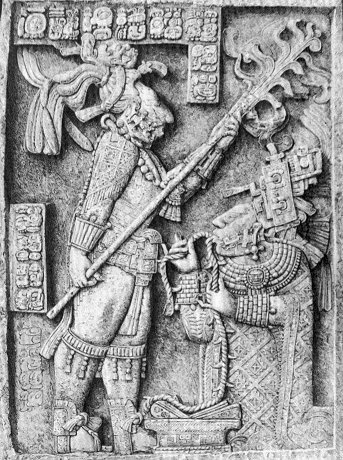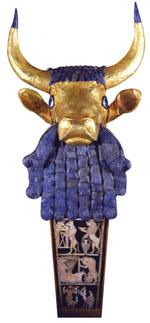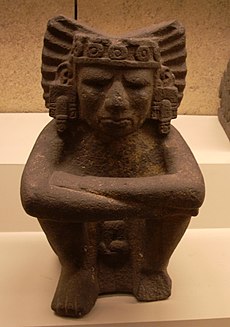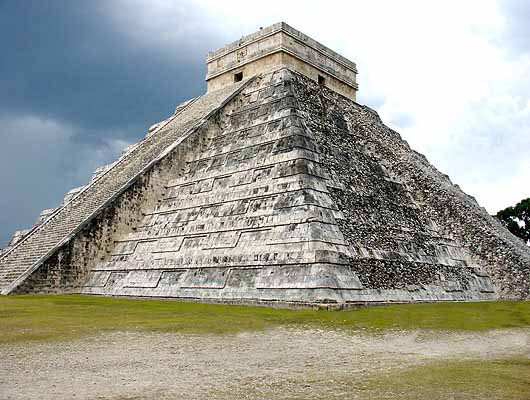The Mayas believed that they must continuously appease the gods to ensure the survival of the world. Their most common way to appease the gods was the sacrifices of captives from warfare. However, when rulers needed to appeal/consult the gods, they shed their own blood as offering. There are repeating cycles of creation and destruction and it was a constant reminder of what would happen if the gods weren't appeased. The Mayas believed they had a responsibility to the gods. It was believed that the gods guided the Sun and Moon across the sky and at night they traveled through the underworld. Mayas believed the gods needed human help because other gods were trying to stop the Sun and Moon from moving in their continuous cycle through the sky and underworld. Sacrifice and bloodletting were simply the price to be paid for the survival of the universe. Its incredible that the Mayas were looking out for the survival of the whole universe, not just their people or Earth. It was considered a privilege to be sacrificed and was thought to give the victim immortality.
 |
| Lady Xoc and her auto-sacrifice |
Bloodletting
All of the Maya rituals were dictated by their ritual calendar, which was different than their solar calendar but ran simultaneously. The ritual calendar was called tzolkin, and was a 260-day cycle with 13 20-day periods sort of like our months in our calendars. Sexual abstinence was strictly observed before and during bloodletting rituals. The act of shedding one's own blood is also known as auto-sacrifice, or bloodletting. The elite were obsessed with offering their own blood. It was considered to be a major part of all important calendar events. The purpose of blood offerings was to send human energy skyward, to replenish the world's supply of life energy, and to receive divine powers from the gods.
 |
| Bloodletting in an altered state |
 |
| One head of the Vision Serpent |
As Lady Xoc views the coils of smoke, the skeletal features of the war god appear from one head, and from the other the found of the Yaxchilan dynasty, Yat Balam, also called Jaguar Penis. Yat Balam is wearing the same headdress as the war god and bears a shield and lance.
A purpose of the bloodletting was so that Lady Xoc could enter an ecstatic state, a state which is believed to allow a person to break through the barrier between the two realms. By doing this, she can communicate with the deities or ancestors to ask advice or request help. The Vision Serpent represents the threshold between realms; the open jaws are the portal through which ancestors and deities pass into the natural realm. In the relief carving, Lady Xoc is asking for the war god and ancestor's help in a battle her husband is about to face. The auto-sacrifice also commemorateed the accession of Shield Jaguar to Yaxchilan's throne and the birth of their son, Bird Jaguar. Said events took place around 724-726 CE.
 |
| Clay Figurine, Male bloodletting his penis |
Men also performed bloodletting. There have been several clay figurines found depicting male nobles sitting cross-legged, holding sharp obsidian knives (obsidian is volcanic glass) or sting ray spines positioned to lacerate their penises. It was considered an act of intense piety. The figure above is dress as a captive with a rope around his neck but he could also be a king or noble wearing the garments of a captive to represent his humility. Mayas believed this act to be essential way to communicate with the realm of the supernatural. Most of the time nobles and rulers were the ones who commonly practiced this, it was considered a privilege. In codices, the gods themselves are depicted performing similar acts on the Maya's behalf. A vase was found that depicted the sun god drawing blood from his penis. Bloodletting was thus symbolized as a reciprocal obligation.
The Mayas also played a game simply called 'the ballgame' in which the losing team would be sacrificed to the gods. Generally the losing team was captives and they were starved or wounded in order to ensure the outcome of the game. The game could also be played a second time with one of the losing team's members head wrapped up and used as a ball. The exact rules of this game are unknown. The game was symbolic of life-and-death battle during creation. The court floor represented earth's platform, which separates the human world from the supernatural world. The gods determined the winners of the game, just like they determined who won warfare. The game was really a huge entertainment for the gods. The Spanish's first reaction to the game was that it was a popular entertainment game for the Mayas. Oh were they very right and wrong in that statement. In a way, sacrifice is entertainment to the Mayas.
Blood Offerings
The Mayas used the primary Aztec method of slicing the victim's chest open and taking out the heart to offer to the gods. The priest generally oversaw the ritual. Four aged men, called chacsin, honor of the rain god, held the victim on the sacrificial stone while a specialist, called nacom, cut open the victim's chest.
 |
| Depiction of young woman at 'Lord and Lady Begin to Dance' |
A festival called 'Lord and Lady Begin to Dance Festival', was celebrated in honor of Ixchel, goddess of the moon, beehives, fertility, medicine and wearing. A pretty young woman was chosen by craftsman to represent Ixchel. She was then sacrificed by priests and flayed. Her skin was then worn by a man who would sit at a loom and pretend to weave while the craftsman danced around him in animal costumes. The festival was complete when worshipers performed bloodletting and had a ritual bath.
 |
| Example of a cenote that Maya victims would be thrown down. |
Other sacrifice types included simply cutting off the victim's head and casting victims into the waters of their sacred wells, cenotes, to drown.
Death and the Afterlife
The Mayas believed that when one died they entered the underworld through a cave or cenote. However, when a King died, he followed the path linked to the cosmic movement of the sun and fell into the underworld. Since kings were believed to possess powers they were reborn into the sky world to become gods.
The Mayas dreaded natural death because they believed that the soul doesn't immediately/automatically enter paradise at death. The common people were buried underneath their homes with religious articles and personal artifacts from life. The priests' graves contained their books.
 |
| Maya Funerary Urn |
Higher nobles were actually cremated and funerary temples were built above urns. Some people mummified the heads of lords and kept them in family oratories. They even 'fed' them regularly. Talk about weird family members.
Honoring the Dead
Tikal was one of the most powerful Maya kingdoms. It was located in the dense lowland of Peten region in Guatemala. The name derives from the Maya word ti ak'al, which means at the waterhole. It is one of the most important Maya burial complexes. Archaeological evidence says that most of the architecture was built to honor the dead.
 |
| Modern-day Tikal |
North Acropolis contains tombs of early Tikal kings. What is left of Tikal today was the final stage in a long process of construction by the Mayas. At first there was only a small platform supporting a pyramid structure. Over time, successions of rulers dying led to tombs being built over earlier tombs leaving superimposed burials and temples. Many early pyramids have huge plaster masks placed on either side of the central stairway. This could possibly be a sun god representation.
Some of the best Maya artifacts came from grave goods in Tikal. Painted pots depicted rulers enthroned surrounded by servants. The tomb was not thought of as the final resting place of the king. Originally pots would be filled with food and drink to sustain the dead in the afterlife. Drinks made from cacao were the best and most valued ones. In one tomb a set of carved bones was found that depicts the maize god traveling to the underworld in a canoe. After time in the underworld, also called Xibalba, the maize god was resurrected as the creator. The carved bones suggest that Maya kings were thought to undergo a similar journey ending in reincarnation. This seems similar to the Aztec kings being resurrected as gods.
A major burial site was Jaina Island, off the coast of Campeche and west of Uxmal and Kabah. I couldn't find a good map of its location. Its location was important because when viewed from the mainland the island lay in the path of the setting sun. Jaina was a good place for the dead because the Mayas believed that the sun descended into the underworld at night. Something the Ancient Egyptians also believed. The souls could accompany the sun on its nocturnal journey to the underworld. The island may have been reached by a wooden bridge. That fact is also important because the Maya underworld was thought to be below the surface of a primordial ocean that existed before Earth. Jaina is Spanish and the Mayas called it Hanal, house of water.
The graves at this island had a vast array of ritual offerings. However, small clay figures were most commonly found. Many of which were made with molds and were painted bright colors. Some had clay pellets inside and doubled as rattles. Other were hollow to be used as whistles. The best of them were solid, hand crafted pieces for high class burials. Men and women of various rank are portrayed and could represent those laid to rest on the island. Some depict warriors, suggesting the island was a final resting place for those who were excellent in battle. The Maya gods were also depicted on these figures, mainly the sun and moon gods who were believed to have survived the perils of Xibalba. The figures could have be for guidance and encouragement to the deceased in their journey through Xibalba.
The Mayas were thought, for a time, to be a peaceful race. We now know that they were quite the opposite. They would wage wars to gain land and captives. They would sacrifice their own and other peoples to appease their gods. They weren't peaceful, they were living life the way their gods told them they needed to. They were a truly complex culture, far advanced for their time.
The Maya culture is extremely beautiful and complex for being in such an early time. I enjoyed doing both my group project and blog entry on them. I've so much each time it's crazy. I really can't wait to take an ancient civilization class and learn more about them. Thanks for reading!
Citations
Woolf, Greg. Ancient Civilizations: The Illustrated Guide to Belief, Mythology, and Art. Thunder Bay Press. 2005.












